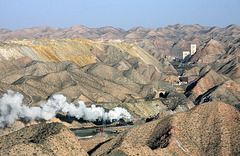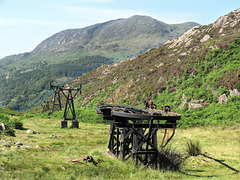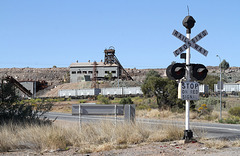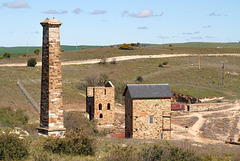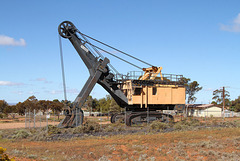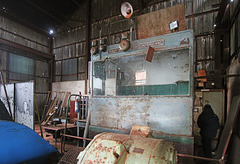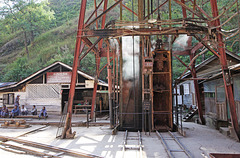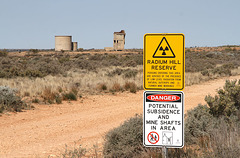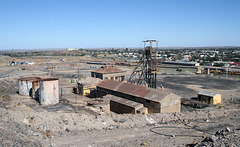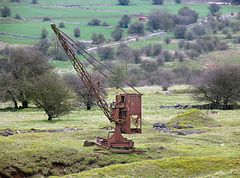
Metal Mining
Copper mine
| |
|
|
|
SY 1583 with the morning empties to the Kuangsan Copper Mine at Shenbutong on the Baiyin Mining Railway. This train ran every day after the morning passenger service has returned from the mine. The exact timing was difficult to predict as it could appear at any time over about four hours. Luckily, on this day there was enough time to climb the hills overlooking the line and take in the amazing views. The winding tower of the mine can be seen in the background with the yellow areas which are the spoil tipping from the now closed adjacent opencast mine.
Ropeway remains
| |
|
|
|
Remains of the aerial ropeway that brought copper ore down from the mine in Cwm Bychan near Beddgelert to the processing mill. Production ceased c1930 and the pylons have remained safe from scrapmen ever since due to the remoteness of the site.
Electric haulage
| |
|
|
A quick chat as the mine locomotive drags empty ore wagons off the tippler at Wallah Gorge above the Burma Mines Railway.
Enginehouse
| |
|
House for a cornish pumping engine at the Pennant lead mine near St Asaph. The associated chimney collapsed many years ago.
Onto the tippler
| |
|
|
An overhead wire electric locomotive pushes a loaded ore wagon onto the tippler at Wallah Gorge above the Burma Mines Railway. I hope that helmet is well insulated!
British Mine
| |
|
|
The Thompson Shaft at British Mine, Broken Hill, was developed from 1910 as this area took over the main production. Winding from this shaft appears to have ended in 1958.
Tankerville Mine - Watson's Shaft
| |
|
|
|
On the western edge of the Stiperstones north east of Shelve village and to the south of Shrewsbury, Tankerville was once one of the most productive Lead Mines in the area. The mine was worked for Baryte, Lead, Silver and Zinc between 1865 and 1925.
This engine house was built for a 40" Cornish engine by Harveys of Hayle in 1876. The octagonal chimney served the boiler house. Watson's Engine Shaft eventually became the deepest shaft in the orefield, with a final depth of 1,700ft (523m). Where the shaft 'doglegged' at 500ft (154m), to follow the vein the vertical motion of the pump rods had to be converted to angular motion. This proved very difficult and caused a lot of wear on the pitwork.
Red buildings
| |
|
|
|
The Florence ironstone mine near Egremont continued in use until 2008. It was the last working deep iron ore mine left in Western Europe and produced ore, products for the cosmetics industry and high quality haematite for jewellery. Production ended when BNFL ended the contrract for the mine to supply water and the cost of pumping rendered the mine uneconomic. The red haematite has had a marked effect on everything it touched, including these buildings on the surface.
Coalpithole Mine
| |
|
|
|
The Peak Forest Mining Company, operated Coalpithole Mine extracting lead ore from 1858 to 1880. The No.10 shaft is under the grille in the right foreground. It is brick lined and around 618 feet deep, sunk through the shale to reach the ore bearing limestone at depth. No.8 shaft is in the trees beyond the pool and the line of the vein on Coalpithole Rake can be seen covered in trees as it runs across the shoulder of the hill. Mining here petered out in 1880 having seen a massive fall in productivity after water ingress overwhelmed the pumps in the mid 1870s.
This panorama shows the blind valley running east from Sparrowpit towards Winnats Head. Rushup Edge is on the left whilst the abandoned Eldon Hill limestone quarry is to the right. Water here drains through the shales and into sink holes in the limestone on the right side of the valley from where it eventually finds its way underground towards Castleton.
Morphett's engine houses
| |
|
|
|
The Burra Burra Copper Mine (The Monster Mine) was established in 1848 mining the copper deposit discovered in 1845. Miners and townspeople migrated to Burra primarily from Cornwall, Wales, Scotland and Germany. The mine first closed in 1877, briefly opened again early in the 20th century and for a last time from 1970-1981. The Burra mines supplied 89% of South Australia's and 5% of the world’s copper for 15 years and the settlement has been credited (along with the mines at Kapunda) with saving the economy of the struggling new colony of South Australia.
The two enginehouses seen here are:
1. (left) Morphett's winding house, built in 1861 to wind rock from Hector shaft, begun in 1858. A 30 inch, 30hp engine with boilers was ordered from Thomas Williams in Devon. Williams actually ordered from Perran Foundry a 30hp rotative beam engine with a cylinder of only 20 inches. The engine house was erected about 300ft from the Hector shaft in order for the boiler house to be shared with Morphett's pumping engine. This had four boilers, to which two more were added for the winding engine. The engine was started in 1861 and was stopped in 1868 when the mine began to convert to opencut operations. It was adapted to drive dressing machinery some 550ft distant via an endless wire rope. A horizontal engine was erected at the dressing plant in 1874 and the winding engine then lay derelict until scrapped in 1916.
2.(right) Morphett's pumping engine house, built in 1858 by Cornish stonemasons Thomas Paynter and Ambrose Harris. It housed an 80 inch Cornish pumping engine purchased new from Perran Foundry which arrived at Burra over a six month period in 1858 with the 15 ton cylinder finally arriving in January of 1859. The engine was started in March 1860 and named after John Morphett, a director of the South Australia Mining Association which owned the mine. Operation of the engine ceased in November 1877 after the shaft had been deepened to the 100 fathom level. It was scrapped in 1916. The engine house was gutted by fire in 1926 but was subject to extensive restoration in 1986 when the upper part of the shaft was also retimbered. It now house an interpretive display relating to the engine and mine.
Face shovel
| |
|
|
This is one of two electric face shovels seen at Iron Knob and surrounding area. It is a product of the Marion Power Shovel Company, Ohio, and may have worked at the Iron Baron ore mine. Earlier models shovels were first introduced at these mines in 1928 and at one time there were three or four Bucyrus-Erie 120B electric shovels in operation. The other survivor is on top of the spoil tip at Iron Monarch mine.
The information panel for this excavator states: "No. 7 Marion all electric shovel commissioned June 1965, cost $38,000. Taken out of service 14 October 1981 after digging more than 24 million tons. Carried own cable of 3300 V. With bucket of 18 tons cap."
Robey & Co
| |
|
Robey winder at the Florence ironstone mine at Egremont in Cumbria. This site has inevitably been robbed and the maker's plate has now been stolen.
Marmion Shaft
| |
|
Marmion Shaft at the Bawdwin lead/zinc mine in north-east Myanmar. It was sunk in 1914 down to the sixth (adit) level at c700ft and was subsequently deepened to serve 14 levels in total to a depth of 1700ft. The winding house contains two electric winders manufactured at the Siemens Works of English Electric at Stafford in the UK in 1925. The ore is trammed out of the mine via a two mile adit known as "Tiger Tunnel".
Radioactive
| |
|
|
|
The Uranium Mine at Radium Hill operated from 1954-1961 and on closure the associated town was abandoned and largely demolished. In the background the remains of the ore bins and loading point close to the site of the shafts are probably the best surviving features of the mine itself. The site has now been closed off and visits banned.
Delprat Shaft
| |
|
|
The Delprat shaft, which was commenced in 1900, is named after Broken Hill Proprietary general manager from 1899 to 1921, G D Delprat. The original wooden headframe was replaced in 1952 with the current steel structure. Winding here ceased in 1972 and the shaft has subsequently seen use as a tourist attraction until nearby mining operations caused its closure in 2007.
Spar crane
| |
|
A walk on Bonsall Moor today found lots of lead mining remains and also a couple of old cranes formerly used in fluorspar operations in the 1940s or 1950s. Abandoned for over 70 years these cranes are still in reasonable condition where they sit alongside the opencut workings.
Jump to top
RSS feed- Latest items - Subscribe to the latest items added to this album
- ipernity © 2007-2024
- Help & Contact
|
Club news
|
About ipernity
|
History |
ipernity Club & Prices |
Guide of good conduct
Donate | Group guidelines | Privacy policy | Terms of use | Statutes | In memoria -
Facebook
Twitter

